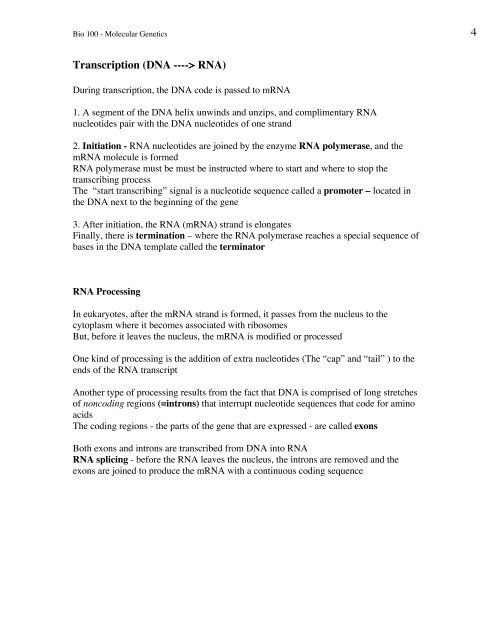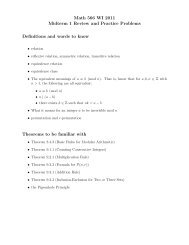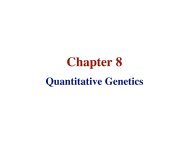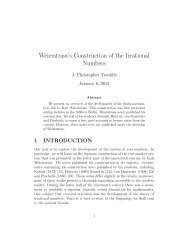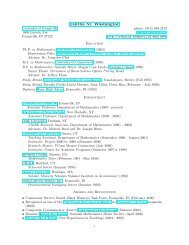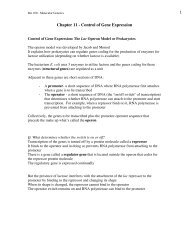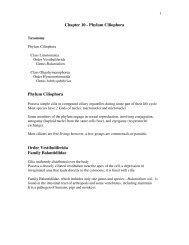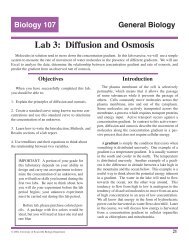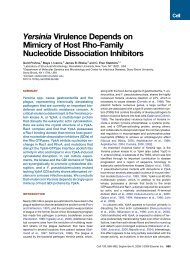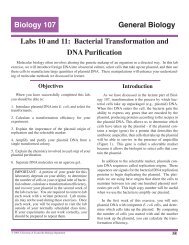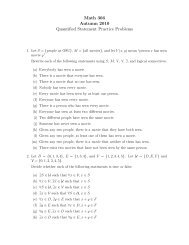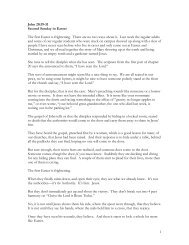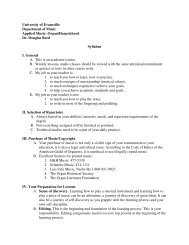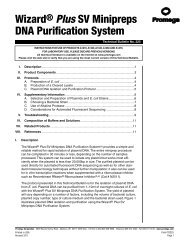Chapter 10 - Molecular Biology of the Gene
Chapter 10 - Molecular Biology of the Gene
Chapter 10 - Molecular Biology of the Gene
You also want an ePaper? Increase the reach of your titles
YUMPU automatically turns print PDFs into web optimized ePapers that Google loves.
Bio <strong>10</strong>0 - <strong>Molecular</strong> <strong>Gene</strong>tics 4Transcription (DNA ----> RNA)During transcription, <strong>the</strong> DNA code is passed to mRNA1. A segment <strong>of</strong> <strong>the</strong> DNA helix unwinds and unzips, and complimentary RNAnucleotides pair with <strong>the</strong> DNA nucleotides <strong>of</strong> one strand2. Initiation - RNA nucleotides are joined by <strong>the</strong> enzyme RNA polymerase, and <strong>the</strong>mRNA molecule is formedRNA polymerase must be must be instructed where to start and where to stop <strong>the</strong>transcribing processThe “start transcribing” signal is a nucleotide sequence called a promoter – located in<strong>the</strong> DNA next to <strong>the</strong> beginning <strong>of</strong> <strong>the</strong> gene3. After initiation, <strong>the</strong> RNA (mRNA) strand is elongatesFinally, <strong>the</strong>re is termination – where <strong>the</strong> RNA polymerase reaches a special sequence <strong>of</strong>bases in <strong>the</strong> DNA template called <strong>the</strong> terminatorRNA ProcessingIn eukaryotes, after <strong>the</strong> mRNA strand is formed, it passes from <strong>the</strong> nucleus to <strong>the</strong>cytoplasm where it becomes associated with ribosomesBut, before it leaves <strong>the</strong> nucleus, <strong>the</strong> mRNA is modified or processedOne kind <strong>of</strong> processing is <strong>the</strong> addition <strong>of</strong> extra nucleotides (The “cap” and “tail” ) to <strong>the</strong>ends <strong>of</strong> <strong>the</strong> RNA transcriptAno<strong>the</strong>r type <strong>of</strong> processing results from <strong>the</strong> fact that DNA is comprised <strong>of</strong> long stretches<strong>of</strong> noncoding regions (=introns) that interrupt nucleotide sequences that code for aminoacidsThe coding regions - <strong>the</strong> parts <strong>of</strong> <strong>the</strong> gene that are expressed - are called exonsBoth exons and introns are transcribed from DNA into RNARNA splicing - before <strong>the</strong> RNA leaves <strong>the</strong> nucleus, <strong>the</strong> introns are removed and <strong>the</strong>exons are joined to produce <strong>the</strong> mRNA with a continuous coding sequence


